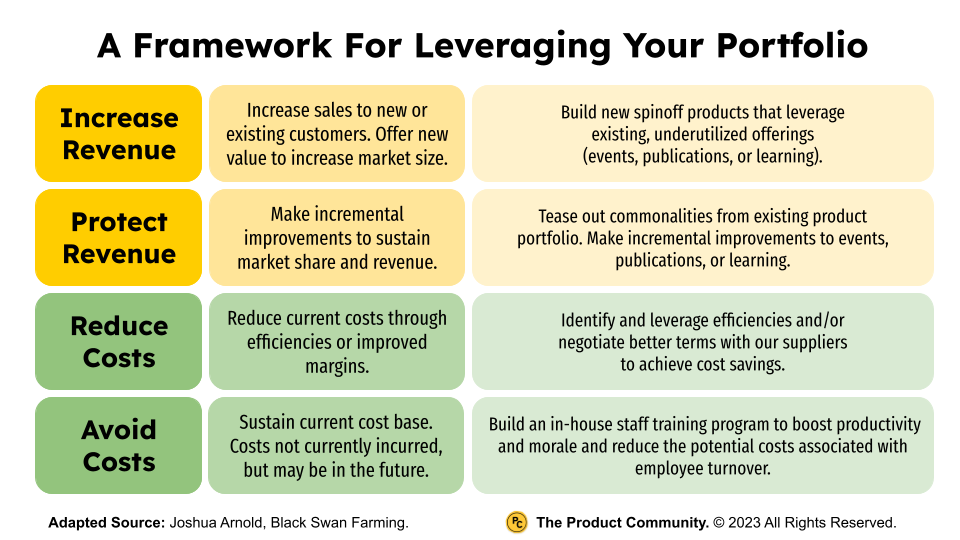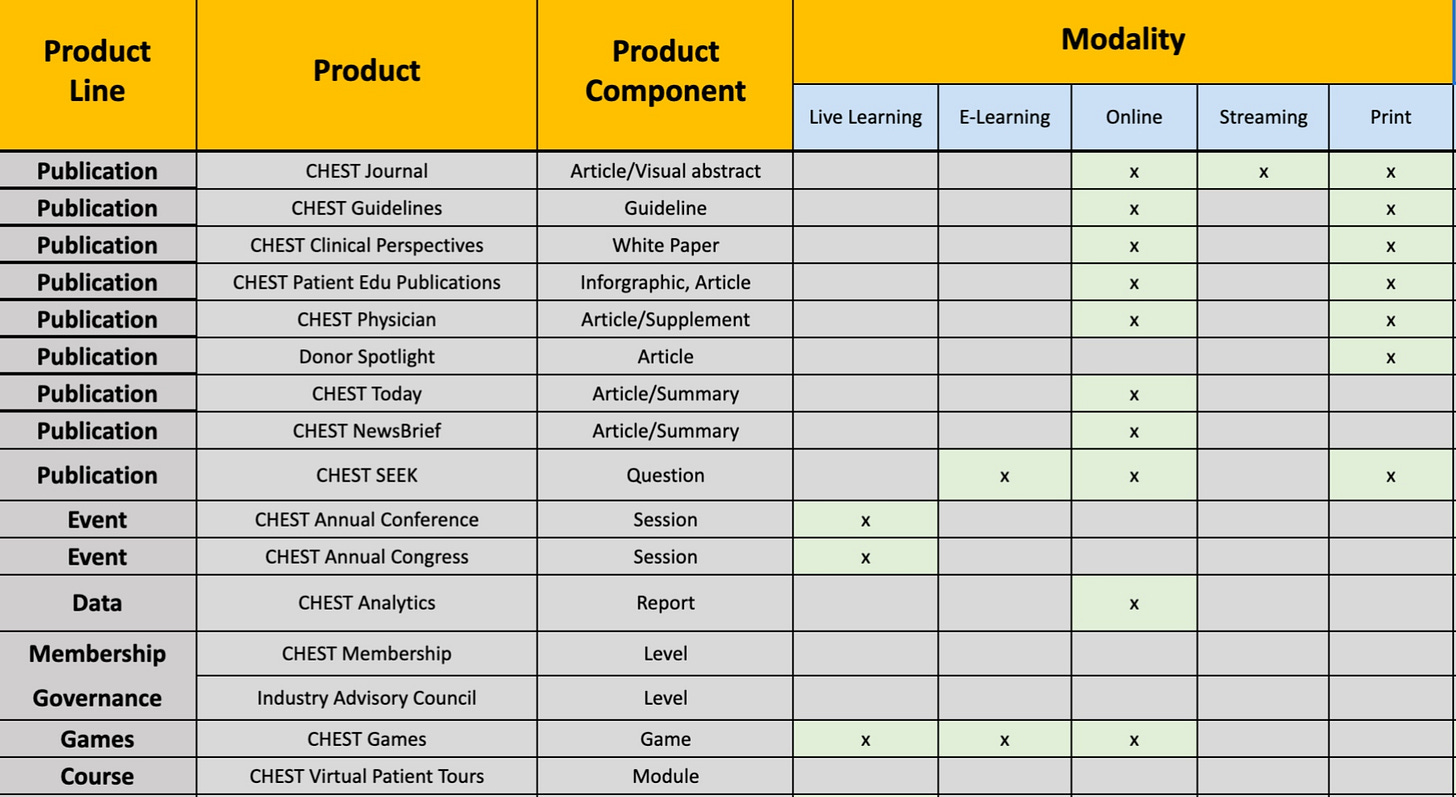Summary
Associations and nonprofits exist to create value for their communities.
We typically do this through the overlapping efforts of engagement (events, volunteer work, fundraisers, mixers, social media, etc.) and offerings (conferences, membership, learning, publications, etc.).
A great way to create consistency and leverage our value is to create a product portfolio. Why? Because our offerings are not valuable unless members are aware of — and can meaningfully engage with — them or their intended value.
This requires us to develop and deliver products in new, more visible ways through diverse channels to a wider community. It also requires us to make choices (what to do, what to stop doing, etc.) based on usable insight derived from the portfolio’s outputs.
The Product Community is a product development learning community designed specifically for associations.
Why It’s Important to Have a Product Portfolio
“There is nothing so useless as doing efficiently that which should not be done at all.”
Peter Drucker
A robust product portfolio helps get new, high-quality products to market efficiently and in anticipation of growing and diverse market needs.
In layperson’s terms, a portfolio is simply a list of what we do. See my article What is a Product? for definitions and insight on how to frame our offerings.
A more mature product portfolio is an intentional way of organizing our programs, services, and products in order to identify value, create linkages, enhance planning, and achieve interdependence across the entirety of the value we create and deliver.
A portfolio can be practical and functional, but can also be used to drive strategy, identify patterns, or reach new markets. It not only helps us determine our relevance, it helps us anticipate how to satisfy our community’s needs (now and in the future).
Before we get into benefits, let’s look at different ways of leveraging our portfolios. Viewed this way, we can leverage our offerings through four levels of risk: increase revenue (highest risk, greatest payoff), protect revenue (average risk, medium payoff), reduce costs (low risk, variable payoff), or avoid costs (high risk, variable payoff).
Independent of which route we take, it is important to create a portfolio. What are the benefits?
It is the basis for creating a shared understanding of what we do, its value, and impact.
It is a clear way of communicating value to our member community.
It helps us tease out patterns, commonalities, strengths, and weaknesses.
It is a baseline for creating and using common metrics (so we can compare performance across product lines).
It provides input on what’s working and what’s not working.
It helps us identify redundancies, duplications, or gaps.
It guides decisions on what to stop doing.
It is a vehicle to help us plan for, and invest in, the future.
It forces us to think holistically and collaboratively as a value-creating organization (not a series of siloed departments).
It helps us communicate to your board about performance, funding, and investments.
Over time, our product portfolio contains only high-performing products. Initially, this may seem easy, but it’s harder than you think. See my article Prioritizing Good Ideas for insight on helping determine when to greenlight new ideas and when to stop a program.
How Does It Work?
“Building a good customer experience does not happen by accident. It happens by design.”
Clare Muscutt
There are many ways of developing a product portfolio. Here are some steps to get you started.
Pull together a diverse team. Ideally our team is cross-functional with a broad and diverse perspective on your association.
Make a list of products. Even if we don’t use this terminology, answer the question: what do we offer? Include all value-drivers, not just the tangible things you sell (this includes membership and sometimes volunteering).
Talk to finance. What are people buying? Can they run reports to help you identify patterns? If you do not have one, create a simple taxonomy of product types (see the section Utilize a Product Taxonomy in the article Leverage for Scale).
Identify the person or unit responsible. Who is responsible for each product?
Describe your current product pipeline. This is the process you take to get from idea to execution on an existing or new product, program, or initiative.
Understand the product life cycle. Your product life cycle is the length of time from when a product is introduced until you no longer offer it. This is one way to determine how vibrant and relevant your offerings are.
Build logical connections. Find areas or commonality across the portfolio in order to find areas you can leverage. What content or programs could be reused?
Conduct a stakeholder analysis. Define the stakeholders for each of your products. Can you map commonalities? Do you see patterns? How might you better serve your community more holistically?
Team build. Use the product portfolio as a tool for team-building and to tease out product similarities.
Review and keep current. Update the portfolio annually.
This table shows a small section of an example product portfolio. Please contact me if you’d like access to my template.
I recommend starting with a simple portfolio that contains just the basic elements. I will cover advanced elements of a product portfolio in a future article.
Basic elements | Used to identify patterns – product line, product name, year of inception, product component (lowest element of the product), modality (how delivered).
Advanced elements | Used to determine performance – market or intended audience, reach, diversification, metrics, positioning, spinoffs, etc.
Building an association-wide product portfolio is one way of creating a shared understanding of what we offer. This may sound overly simplistic, but it’s actually a broad take on our association’s value proposition.
What it can be is a test of your value proposition (see my article on Getting New Association Products to Market for insight on building a value proposition).
The outcomes of developing a product portfolio are the seeds for pushing you toward a system of superior value with the following outcomes:
Each product (or product line) has a clear strategy (value proposition, persona map, buyer’s journey)
Clarified product lines with identified interdependencies (answers: “what do we do?” for each market segment)
Aligned pricing strategy across the portfolio (with a strong link to market positioning)
A high-level product life cycle model
Refined processes for getting good, in-demand ideas to market efficiently
A simple product cost model
A common, repeatable framework for new product creation
A next important step is to create and utilize a product taxonomy (see the section Utilize a Product Taxonomy in the article Leverage for Scale). This way, we can drill deeper into organizing our content, programs, and products into new products and experiences.
Though it’s harder to pull off, eventually tying in more advanced elements of the portfolio will help us create a valuation (monetary worth of our portfolio) and performance index (comparative indicators of how well we’re doing).
Investing in Value Creation
“Be stubborn on vision but flexible on details.”
Jeff Bezos
Associations and nonprofits do many things, but three commonalities unite us: (1) we are purpose-driven, (2) we are community-based, and (3) we are in the value creation business.
Organizing and making available our value – our offerings or what we do to satisfy our mission – is vital to serving our communities. It demonstrates clearly what we do, what value we offer, and what impact we make.
Value creation is our currency.
Creating a product portfolio helps us focus on what’s most important. Instead of offering a bunch of stuff derived from a short-term lens / resource-intensive hamster wheel, we should focus on understanding, reaching, and empathizing with our stakeholders.
This continuous discovery only deepens, refines, and helps us prune our portfolio. It also offers meaningful patterns and insight built on sustained relationships.
Remember, product-led growth fuels connection. Join the product community and flip your destiny.
About the Author
James Young is founder and chief learning officer of the product community®. Jim is an engaging trainer and leading thinker in the worlds of associations, learning communities, and product development. Prior to starting the product community®, Jim served as Chief Learning Officer at both the American College of Chest Physicians and the Society of College and University Planning.
Please contact me for a conversation: james@productcommunity.us.





